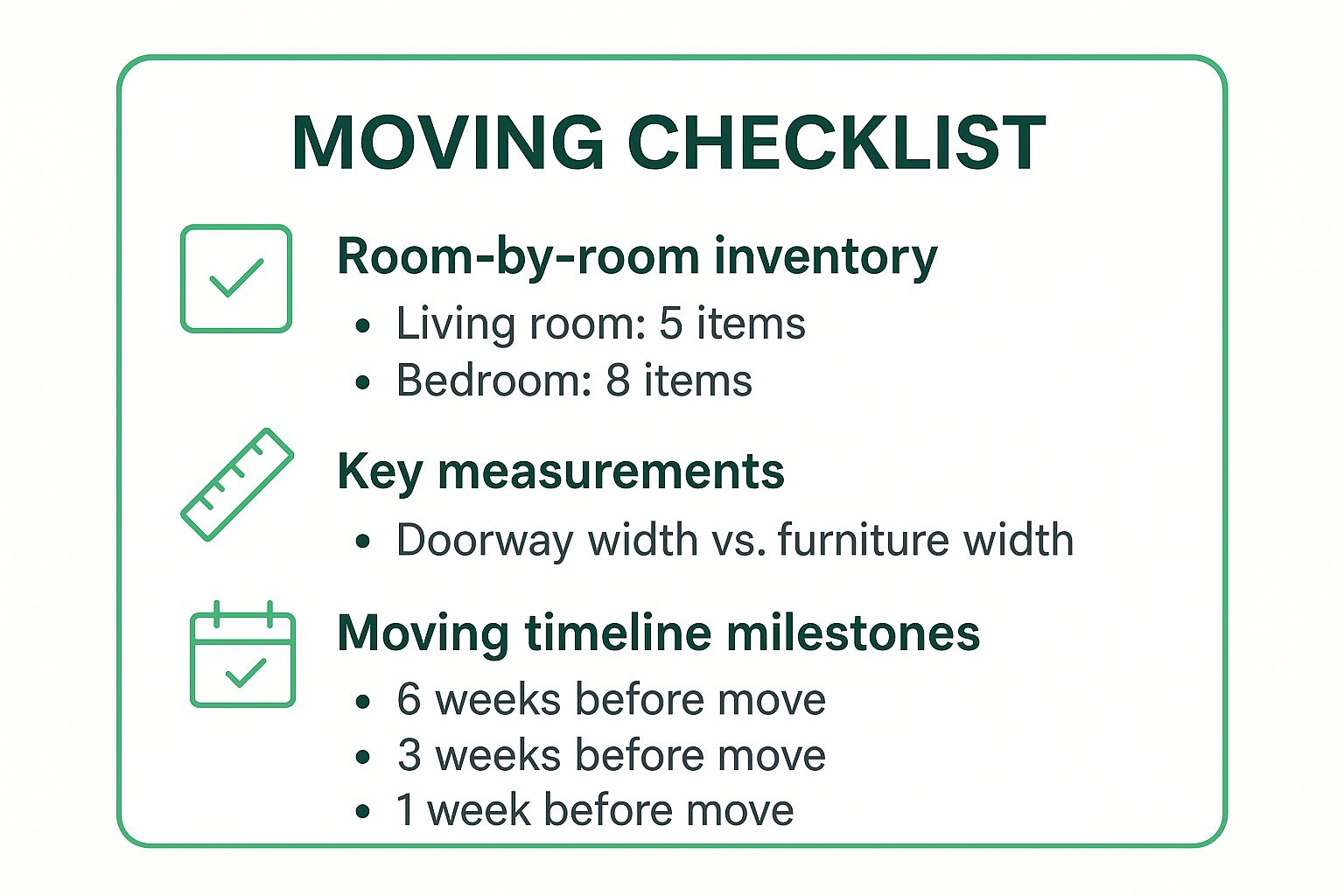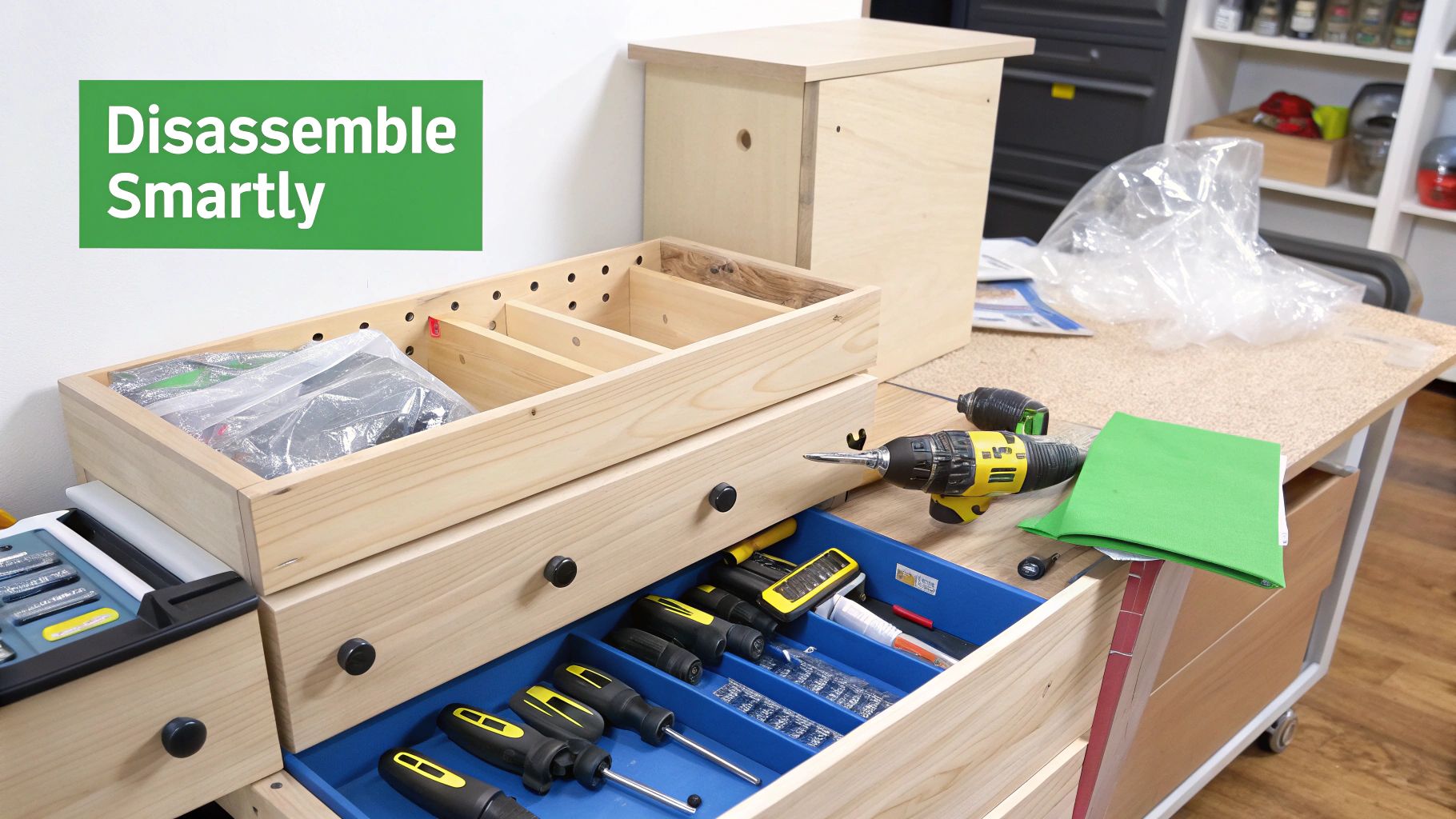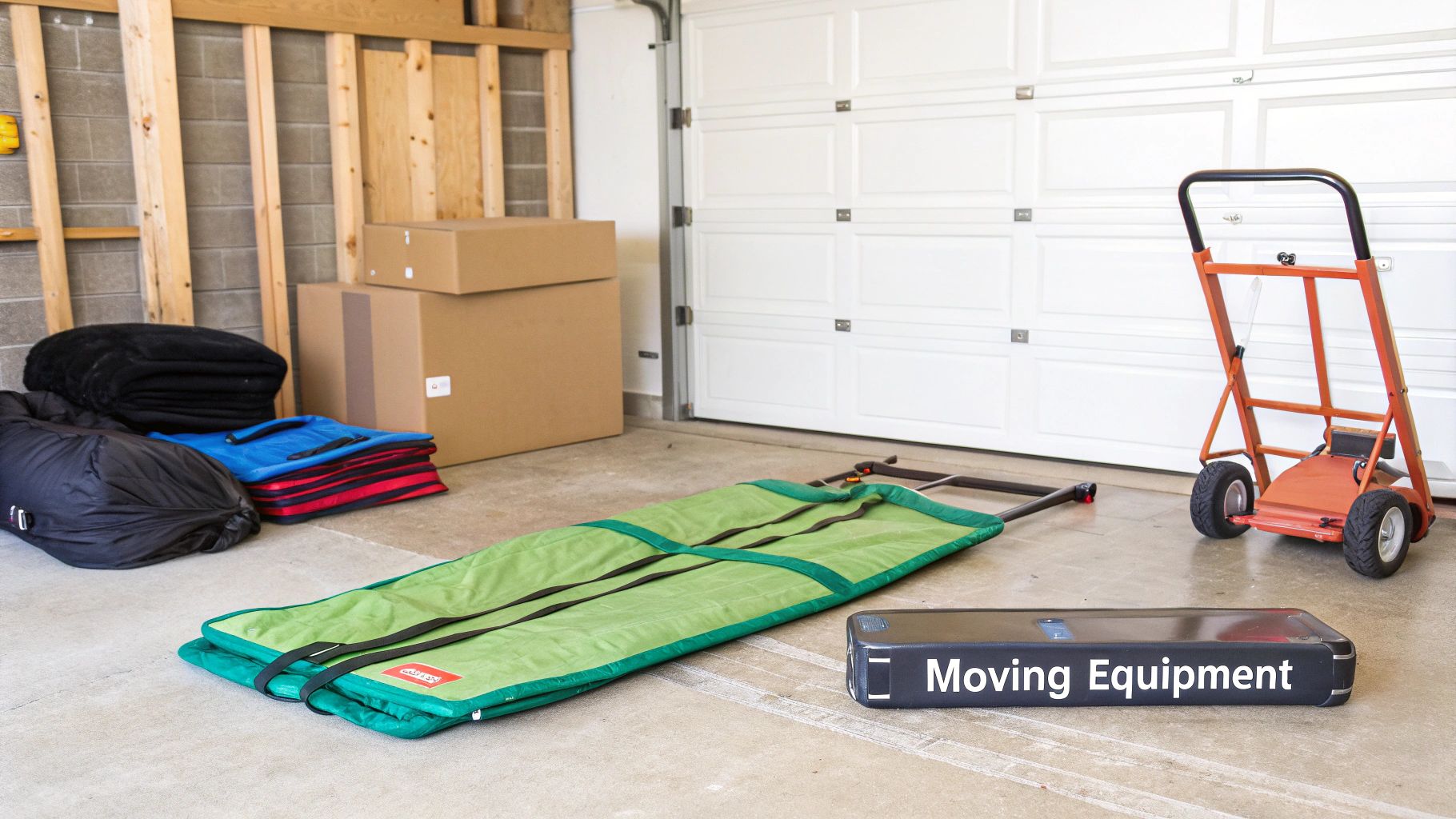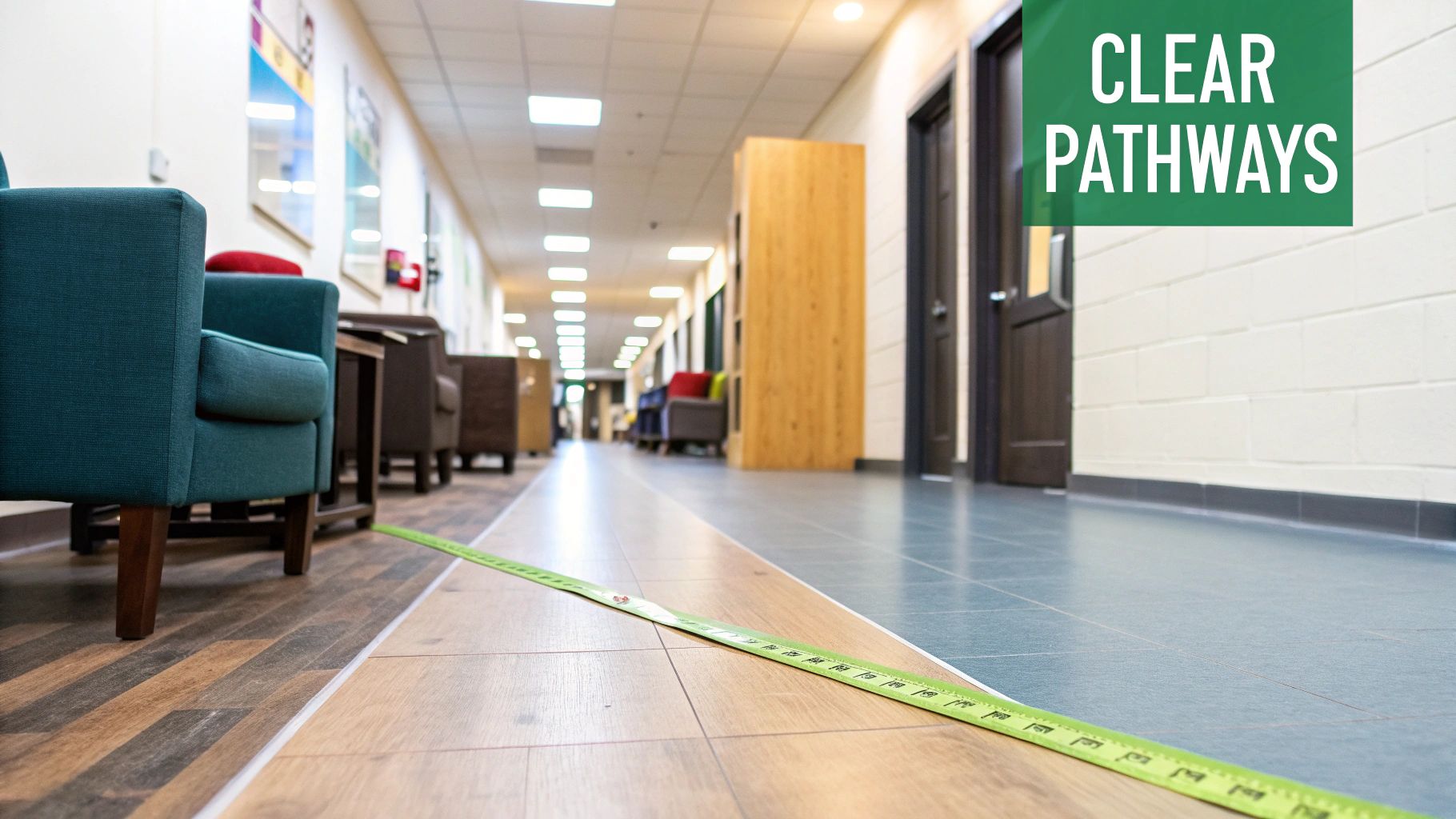Moving homes or offices can be one of life's more demanding tasks, and the thought of safely relocating your cherished furniture often adds a significant layer of stress. From that cumbersome sofa that barely fit through the door to the delicate antique cabinet passed down through generations, each piece presents a unique logistical challenge. Inefficient planning or improper technique can quickly lead to damaged valuables, strained backs, or costly scratches on walls and floors. This guide is organised to provide you with actionable, expert-approved furniture moving tips that go beyond the obvious advice.
We will provide a clear roadmap to navigate the entire process with confidence. This listicle breaks down the essentials into eight comprehensive steps, offering practical insights that ensure your belongings are handled with care. We'll explore detailed strategies for everything from creating a meticulous inventory and disassembling items correctly, to using proper lifting mechanics and investing in the right equipment. You'll learn how to protect surfaces, plan your route effectively, and load a moving vehicle like a seasoned professional.
By following these essential steps, you can transform your next move from a chaotic ordeal into a smooth, organised, and damage-free experience. Whether you're moving a large house across Sydney, a small apartment in Melbourne, or simply rearranging your living room, these insights will help ensure your furniture arrives at its new destination in perfect condition. We will also cover the critical decision of when it’s more sensible and cost-effective to hire professional movers.
1. Create a Detailed Moving Plan and Inventory
The cornerstone of any successful furniture relocation lies not in brute strength, but in meticulous preparation. Developing a comprehensive moving plan and a detailed furniture inventory is the most critical first step, transforming a potentially chaotic process into a structured, manageable project. This foundational strategy involves more than just listing what you own; it's about creating a strategic blueprint for the entire move.
Why a Detailed Plan is Essential
A well-organised plan eliminates guesswork and last-minute panic. By documenting every piece of furniture, you can anticipate challenges, allocate resources effectively, and ensure nothing gets left behind or damaged. This is one of the most effective furniture moving tips because it provides clarity from start to finish. For instance, knowing the exact dimensions of your antique armoire and the width of your new home's hallways can prevent a stressful and damaging moving day bottleneck.
Start this process at least four to six weeks before your move. This gives you ample time to measure, document, and strategise without feeling rushed.
Creating Your Furniture Inventory
Your inventory should be a detailed record of every furniture item being moved. For maximum efficiency, use a system that works for you:
- Spreadsheet Method: Create a simple spreadsheet with columns for Item Name, Room (Origin), Room (Destination), Dimensions (L x W x H), and Notes (e.g., "fragile legs," "disassemble before moving").
- Digital Apps: Leverage technology like MagicPlan or RoomScan Pro to create digital floor plans and easily capture room and furniture dimensions with your smartphone's camera.
- Colour-Coding: Assign a specific colour to each room in your new home. Use coloured stickers on each piece of furniture corresponding to its destination room. This simple visual cue makes unloading and placement incredibly efficient for you or your movers.
Before you finalise your furniture placement, think strategically about how each piece will function in the new space. Taking time to consider ideas for optimizing small living room layouts, for example, can make your new house feel like a home much faster and prevent the need to move heavy items twice.
The following graphic outlines the key components of a well-structured moving plan.

As the summary shows, integrating inventory counts, crucial measurements, and a clear timeline provides a complete operational overview for your move. This detailed approach ensures every piece is accounted for and every logistical challenge is addressed proactively.
2. Disassemble Furniture Strategically
Attempting to wrestle a fully assembled king-size bed frame through a narrow doorway is a recipe for scratched walls and strained backs. Strategic furniture disassembly is the art of breaking down large items into smaller, more manageable components. This technique is not just about making things smaller; it's a critical safety and preservation measure that makes navigating tight corners, stairwells, and doorways significantly easier and safer.

Why Strategic Disassembly is a Game-Changer
The core benefit of this approach is risk mitigation. Disassembled pieces are lighter, less awkward to carry, and can be packed more securely in a moving truck, reducing the likelihood of damage to both the furniture and your property. This is one of the most practical furniture moving tips because it directly addresses the physical challenges of relocation. For example, a large dining table can be moved with ease once its legs are removed, and a bulky modular sofa becomes a simple set of individual sections.
This process should be tackled a few days before the move, allowing you to work methodically without the pressure of moving day looming. The philosophy popularised by flat-pack giants like IKEA has demonstrated that most modern furniture is designed to be assembled and disassembled with relative ease.
How to Disassemble Like a Pro
A haphazard approach can lead to lost hardware and reassembly headaches. Follow a structured process for a smooth experience:
- Document Before You Start: Before removing a single screw, take clear photos or a short video from multiple angles. This visual record is invaluable for remembering how everything fits back together.
- Bag and Label Hardware: Use small, sealable plastic bags for all screws, bolts, and washers. Use a permanent marker to label each bag with the name of the furniture piece and the specific part it belongs to (e.g., "Dining Table – Leg Bolts"). Tape the bag securely to the largest corresponding component.
- Keep Tools Handy: A basic toolkit with screwdrivers, Allen keys, and a wrench is usually sufficient. A magnetic bowl is an excellent tool for keeping track of screws as you work, preventing them from rolling away and getting lost.
- Be Selective: Not everything needs to be taken apart. Focus on items that are too large, heavy, or awkwardly shaped to move safely in one piece. This includes bed frames, large tables, modular shelving units, and some office desks. If an item is sturdy and can fit through all doorways, it may be best to leave it assembled.
Ultimately, strategic disassembly isn't about creating more work; it's about working smarter. By simplifying your largest items, you ensure they arrive at your new home in the same condition they left the old one, making the reassembly process organised and stress-free.
3. Use Proper Lifting Techniques and Body Mechanics
Beyond having the right tools, the most important instrument in any furniture move is your own body. Using correct lifting techniques and body mechanics is non-negotiable for preventing serious injury. This approach, heavily promoted by bodies like the Occupational Safety and Health Administration (OSHA), prioritises safety and sustainability over sheer force, ensuring you can complete the move without strain or harm.
Why Proper Technique is Essential
Incorrectly lifting a heavy or awkward item, even once, can lead to debilitating back, neck, or knee injuries. Proper technique shifts the strain from your vulnerable spinal column to your powerful leg and core muscles. This is one of the most critical furniture moving tips because it directly addresses personal safety. Professional movers, like those trained by major van lines, undergo extensive training in these principles to maintain their health and work effectively day after day. It's about working smarter, not harder, to protect your physical wellbeing.
Adopting these methods minimises the risk of pulled muscles, herniated discs, and other painful injuries that can arise from a single moment of poor form.
Implementing Safe Lifting Practices
Mastering safe lifting is a skill that requires conscious effort and communication. Follow these established guidelines to protect yourself and your moving partners:
- Lift with Your Legs: Always bend at your knees and hips, keeping your back straight. Never bend forward at the waist to pick up an object. This keeps the load centred and engages your strongest muscles.
- Maintain a Secure Grip: Get a firm hold on the furniture with both hands before you attempt to lift it. Keep the item close to your body’s centre of gravity to maintain control and reduce leverage-based strain.
- Avoid Twisting: To change direction, move your feet. Pivoting or twisting your torso while holding a heavy load places immense, dangerous pressure on your spine.
- Communicate Clearly: When lifting with a partner, establish clear, simple commands. Use words like "Ready? Lift on three. One, two, three, LIFT," and "Ready to set down? DOWN." This synchronisation prevents sudden shifts in weight.
- Pace Yourself: Take frequent breaks, roughly every 30-45 minutes, to rest and recover. Fatigue leads to sloppy form and is a primary cause of moving-day injuries.
Understanding these fundamentals is key, but for a more in-depth guide, you can find further information on how to move heavy furniture safely.
The following video from a physical therapist demonstrates the correct posture and movements for safe lifting.
As the video illustrates, proper body mechanics are not just about strength but about precise, controlled movements. By internalising these practices, you transform a high-risk activity into a safe and efficient process, protecting your most valuable asset: your health.
4. Invest in Quality Moving Equipment and Tools
Using the right moving equipment transforms furniture moving from a gruelling physical challenge into a manageable, strategic task. Quality tools like dollies, furniture sliders, and moving straps not only make the job easier but also significantly reduce the risk of damage to your furniture, floors, and walls. The modest investment in proper equipment often pays for itself by preventing costly repairs and reducing physical strain.

Why Quality Equipment is Crucial
Attempting to move heavy items without the proper tools is one of the quickest ways to cause injury or damage. A professional-grade appliance dolly, for example, makes moving a refrigerator a two-person job rather than an impossible lift. This is one of the most practical furniture moving tips because it directly addresses the physical reality of the move, prioritising safety and efficiency over brute force.
Think of these tools as a temporary, essential extension of your moving capabilities. They provide leverage, protection, and mobility that human strength alone cannot match, ensuring your prized possessions arrive at your new home in the same condition they left.
Essential Equipment and How to Use It
Building your moving toolkit involves selecting the right tools for your specific furniture and home layout. You can often rent these from moving companies or hardware stores.
- Four-Wheel Furniture Dolly: A flat, wheeled platform ideal for moving large, boxy items like dressers, chests, and heavy boxes. Centre the item on the dolly for stability.
- Appliance Dolly (Hand Truck): An L-shaped, upright dolly with straps, essential for tall, heavy items like fridges, washing machines, and filing cabinets. Secure the item tightly with the straps before tipping and rolling.
- Furniture Sliders: Place these small plastic or felt-bottomed discs under the corners of heavy furniture. They allow you to slide items smoothly across carpet or hard flooring with minimal effort, preventing scratches.
- Moving Straps/Lifting Straps: These harnesses use leverage to make heavy items feel significantly lighter. They are particularly effective for navigating stairs with bulky furniture like mattresses or sofas.
- Moving Blankets and Pads: Do not underestimate the value of thick, padded blankets. Wrap them generously around all furniture to protect surfaces from scratches, dents, and dirt during transit.
When choosing a dolly, look for one with non-marring, pneumatic (air-filled) tyres. These provide a smoother ride over uneven surfaces like thresholds and cracked pavement, better protecting your furniture from jarring impacts.
5. Protect Furniture and Surfaces During Transport
Successful furniture moving isn't just about getting items from point A to point B; it's about getting them there in the same condition they left. Comprehensive protection involves a two-pronged approach: safeguarding the furniture itself and protecting the property surfaces it travels across, like floors, walls, and doorways. This strategy uses appropriate wrapping materials, padding, and temporary coverings to prevent scratches, gouges, dents, and other common moving day damage.
Why Comprehensive Protection is Crucial
Even a minor scuff on a wooden table or a chip in a plaster wall can sour the moving experience. Proper protection is one of the most vital furniture moving tips because it mitigates the risk of costly repairs or irreversible damage to cherished possessions. Think of it as creating a protective cocoon for your items and a temporary shield for your home. Professional movers, from large companies like Atlas Van Lines to specialty art handlers, never move an item without first securing it completely.
This protective step should be performed just before the items are ready to be moved out of the room. It’s the final preparation before the heavy lifting begins, ensuring everything is secure for its journey.
Implementing Your Protection Strategy
A systematic approach to wrapping and padding will ensure maximum safety for your belongings and property. Don't cut corners here; the time spent is a worthwhile investment.
- Wrap Major Surfaces: Use thick, heavy-duty moving blankets to cover large, flat surfaces like tabletops, the sides of dressers, and headboards. These provide excellent cushioning against bumps and impacts.
- Secure with Plastic Wrap: Once blankets are in place, use stretch plastic wrap to hold them securely. This prevents the blankets from slipping off during transit and adds a layer of protection against moisture and dirt.
- Address Vulnerable Points: Pay special attention to corners, edges, and legs. Use bubble wrap, foam corner protectors, or even corrugated cardboard for extra padding in these high-impact areas.
- Protect Your Property: Lay down Ram Board or thick cardboard runners on floors to create a protective pathway. Pad door frames and tight corners where furniture is likely to make contact.
- Secure Loose Parts: Before wrapping, ensure all drawers are either removed and moved separately or secured shut. Tape any loose cabinet doors closed to prevent them from swinging open unexpectedly.
By combining these techniques, you create a robust defence against the rigours of transport. For a deeper look into professional techniques, exploring specialised resources on furniture protection for moving can provide even more advanced insights. This proactive measure ensures both your furniture and your homes, old and new, remain pristine throughout the entire process.
6. Plan Your Route and Clear Pathways
A significant portion of moving day stress and potential damage occurs not in the truck, but within the confines of your own home. Strategically planning the route your furniture will travel, from its current spot to the moving vehicle and into its new location, is a crucial step. This involves meticulously mapping out the path, identifying and mitigating obstacles, and ensuring a clear, safe passage for every item.

Why a Clear Path is Non-Negotiable
A pre-planned and cleared route prevents pivots in tight spaces, scrapes against walls, and the dreaded "it won't fit" moment. This foresight is one of the most practical furniture moving tips because it directly minimises the risk of injury and damage to both your belongings and your property. Think of how professional piano movers survey a home; they don't just lift and hope, they plan every turn, doorway, and stairwell in advance, sometimes even considering window removal for the safest path.
This planning should be done after you have your inventory but before the moving day itself. It allows you to address issues proactively rather than reactively amidst the chaos of the move.
How to Map Your Furniture's Journey
Creating a clear path is a physical task that requires attention to detail. Your goal is to create an unobstructed "highway" for your furniture.
- Measure Everything: Use a tape measure to get the dimensions of your largest pieces of furniture (at their widest, tallest, and deepest points). Compare these measurements against every doorway, hallway, and stairwell on the exit and entry routes. Don't forget to check for low-hanging light fixtures or low ceilings on staircases.
- Clear the Way: Remove all potential hazards from your planned route. This includes rolling up area rugs, securing loose cords, and moving smaller items like plants, lamps, and decorative objects completely out of the way.
- Widen the Path: For particularly tight doorways, you can gain an extra couple of centimetres of clearance by removing the door from its hinges. It’s a simple task that can prevent significant damage. Prop doors open securely so they don't swing shut unexpectedly.
- Designate "No-Go" Zones: Use painter's tape on the floor to mark the cleared pathway. This provides a clear visual guide for everyone involved, ensuring the path remains unobstructed throughout the moving process.
By engineering a clear and measured route, you transform the movement of each item from a guessing game into a predictable, safe, and efficient operation. This methodical approach is a hallmark of a well-organised move, safeguarding your furniture from start to finish.
7. Load and Arrange Furniture Strategically in Moving Vehicle
How you load the moving truck is just as important as how you pack the boxes. Strategic loading is the art and science of arranging furniture and other belongings within the vehicle to maximise space, protect your items, and ensure a safe, stable journey. This technique transforms the truck into a well-organised, three-dimensional puzzle, preventing damage from shifting items and often saving you from needing a second trip.
Why Strategic Loading is Essential
Proper loading is one of the most crucial furniture moving tips for ensuring everything arrives in one piece. A poorly loaded truck can lead to scuffs, dents, broken legs, and shattered glass as items shift and collide during transit. By systematically placing items based on weight, size, and fragility, you create a stable, interlocked structure that can withstand bumps and turns on the road. This methodical approach, popularised by professional movers and logistics companies, significantly reduces the risk of damage.
This process should be planned just before you begin moving items out of the house. Having all your furniture wrapped and ready allows you to focus solely on the loading sequence without interruption.
How to Load Your Moving Truck Like a Pro
The goal is to distribute weight evenly and use every available centimetre of space. Think of it as building a solid wall of your belongings, layer by layer, from front to back.
- Heaviest Items First: Always load the heaviest and largest items first, placing them against the front wall of the truck (the end closest to the cab). This includes appliances like refrigerators and washing machines, as well as large furniture like sofas and dressers. This placement ensures the weight is over the truck's axles, providing greater stability.
- Build Tiers and Walls: After the heavy base is established, load longer items like mattresses, box springs, and tabletops along the sides of the truck to create "walls." You can then fill the space between these walls with other items, working from the floor to the ceiling.
- Use All Vertical Space: Don't be afraid to stack sturdy boxes and furniture. Place heavier boxes on the bottom and lighter ones on top. Desks, tables, and chairs can often be stacked, but ensure you place protective padding between surfaces to prevent scratches.
- Fill the Gaps: Tuck smaller boxes, bags of soft goods like linen, and other miscellaneous items into any available gaps. Fill hollow spaces inside wardrobes, dressers, and nightstands with lightweight items to maximise your space.
- Secure Everything Tightly: Use ratchet straps or moving ropes to secure each tier of items as you go. Create an "X" pattern with the straps across the back of your loaded section to hold everything firmly against the front wall and prevent any movement.
By following this loading hierarchy, you protect your most valuable furniture and create a much safer and more efficient transport environment. This systematic approach is the difference between a stressful move with damaged goods and a smooth, successful relocation.
8. Know When to Hire Professional Movers
While the DIY approach can be rewarding for some aspects of moving, knowing when to call in professionals is one of the most crucial furniture moving tips. Recognising the limits of your own abilities, time, and equipment is a strategic decision that protects your belongings, prevents personal injury, and can ultimately save you money by avoiding costly damages. It’s about evaluating the move's complexity and acknowledging when specialised expertise is not just a luxury, but a necessity.
Why Professional Expertise Matters
Hiring professional movers is an investment in efficiency, safety, and peace of mind. They possess the training, specialised equipment, and insurance coverage that a typical DIY move lacks. Attempting to manoeuvre a priceless antique grand piano or a heavy marble-topped sideboard without proper knowledge and tools can lead to disastrous results for both the item and your home. Professionals transform a high-risk, high-stress task into a routine, streamlined operation.
Deciding to hire professionals is especially important for complex situations like moves involving multiple flights of stairs in a narrow apartment building or long-distance relocations where logistics are paramount.
Scenarios Demanding Professional Movers
Certain items and situations almost always require a professional touch. For maximum protection and a smooth process, consider hiring experts for:
- High-Value and Antique Items: Furniture with significant monetary or sentimental value, such as antique armoires or heirloom dining sets, requires specialised handling, climate-controlled transport, and proper insurance. The cost of hiring a pro is minimal compared to the potential loss.
- Large, Awkward, and Specialised Pieces: Items like pianos, pool tables, oversized sofas, and large glass tabletops need specific equipment (piano boards, heavy-duty dollies, hoisting straps) and experienced teams to move them safely.
- Physically Demanding Moves: If you have physical limitations, lack sufficient help from able-bodied friends, or are facing a move with difficult access like steep staircases or narrow corridors, professionals have the strength and technique to navigate these challenges without injury.
- Time-Sensitive Relocations: When you are constrained by a tight schedule due to work, family, or settlement deadlines, a professional crew can pack, load, and transport your furniture with an efficiency that is nearly impossible to replicate on your own.
Choosing the right team is vital. It's wise to get several quotes and do your research, and you can discover more by reading these expert tips to select furniture removalists to ensure you partner with a reputable company. Verifying their licensing, insurance, and customer reviews from sources like the Better Business Bureau will help you make a confident and informed decision.
Furniture Moving Tips: Key Strategies Comparison
| Aspect | Create a Detailed Moving Plan and Inventory | Disassemble Furniture Strategically | Use Proper Lifting Techniques and Body Mechanics | Invest in Quality Moving Equipment and Tools | Protect Furniture and Surfaces During Transport | Plan Your Route and Clear Pathways | Load and Arrange Furniture Strategically in Moving Vehicle | Know When to Hire Professional Movers |
|---|---|---|---|---|---|---|---|---|
| Implementation Complexity 🔄 | Medium – requires detailed documentation and updates | High – needs mechanical skills and patience | Medium – requires training and practice | Medium – equipment selection and usage learning | Medium – involves multiple protection steps | Medium – detailed measurements and planning needed | High – skill and experience required | Medium – decision-making based on many factors |
| Resource Requirements 💡 | Time-intensive; use of apps and spreadsheets | Tools and labeled bags; photographic documentation | Training and cooperation; possibly mechanical aids | Investment in or rental of specialized equipment | Protective materials and storage space | Measuring tools and possibly temporary removals | Straps, tie-downs, secure packing materials | Financial cost; research time; access to reputable movers |
| Expected Outcomes 📊 | ⭐⭐ Reduces mistakes, improves coordination | ⭐⭐⭐ Minimizes damage, easier transport through spaces | ⭐⭐ Prevents injury, improves teamwork | ⭐⭐⭐ Increases speed, reduces effort, protects goods | ⭐⭐ Prevents damage to furniture and property | ⭐⭐ Smooth move with fewer obstacles and damage | ⭐⭐⭐ Maximizes space, minimizes trips, ensures safety | ⭐⭐⭐ Reduces risk, saves time, provides insurance benefits |
| Ideal Use Cases 💡 | Planning moves of any size; complex household moves | Large, bulky furniture or items with complex assembly | Moves requiring heavy lifting and safety emphasis | Frequent movers or moves involving heavy/awkward items | Moves with valuable/delicate furniture | Moves involving complex routes, narrow or obstructed paths | Moves requiring efficient vehicle loading and safety | High-value, complex, long-distance, or physically difficult moves |
| Key Advantages ⭐ | Reduces stress & surprises; cost estimation | Reduces bulk & damage; easier navigation | Injury prevention; better lifting efficiency | Significant physical strain reduction; speed boost | Maintains furniture value; protects property | Prevents blockage; speeds process; improves safety | Space optimization; load security; reduces trips | Professional expertise; insurance; handles complex scenarios |
Make Your Next Move Your Best Move
Moving house can feel like an overwhelming puzzle, with each piece of furniture representing a unique challenge. However, as we've explored, transforming this complex task into a manageable, and even successful, project is entirely within your grasp. The key isn't brute force or wishful thinking; it's the strategic application of knowledge and preparation. By embracing a methodical approach, you can navigate your next relocation with confidence, ensuring your cherished belongings arrive at their new home in the same condition they left.
The core message woven through all our advice is that preparation is paramount. The most effective furniture moving tips are those implemented long before you lift a single box. A well-organised move begins with a detailed inventory and a strategic disassembly plan, turning a chaotic jumble of tasks into a clear, step-by-step process. This initial planning phase sets the foundation for everything that follows, from selecting the right packing materials to loading the truck efficiently.
From Strategy to Execution: Key Takeaways
Mastering the physical side of the move is just as crucial. The difference between a smooth relocation and a day filled with frustration, damage, and potential injury often comes down to technique and tools. Let’s recap the most impactful actions you can take:
- Protect Your Body: Proper lifting techniques are non-negotiable. Always lifting with your legs, keeping your back straight, and avoiding twisting motions are fundamental principles that protect you from serious strain. Remember the mantra: "Think before you lift."
- Protect Your Furniture: Your furniture is an investment. Using moving blankets, bubble wrap, and stretch wrap isn't an optional extra; it's essential insurance against scratches, dents, and breakages. Similarly, protecting floors, walls, and door frames with cardboard or pads prevents costly cosmetic repairs in both your old and new homes.
- Optimise Your Logistics: Efficiency is your best friend on moving day. Clearing pathways, planning your route to avoid obstacles, and loading the moving vehicle with a "heavy-to-light, back-to-front" strategy will save you time, energy, and unnecessary effort.
Key Insight: A successful move is a direct result of the quality of your planning and the care you take in execution. It’s a process where thoughtful strategy consistently outperforms rushed effort.
Knowing When to Call for Reinforcements
Perhaps the most valuable of all furniture moving tips is recognising your own limitations. While the DIY spirit is commendable, some tasks are simply too large, too complex, or too risky to handle alone. Moving exceptionally heavy items like pianos or slate pool tables, navigating tight stairwells with bulky wardrobes, or relocating delicate antiques requires a level of expertise and specialised equipment that most people don't possess.
This is where professional movers prove their worth. Acknowledging the need for expert help isn't a sign of failure; it's a smart, strategic decision that prioritises safety and the preservation of your valuable assets. Professionals bring not only the muscle but also the experience to foresee potential problems and execute the move with practiced efficiency, turning a stressful ordeal into a seamless transition. By applying these comprehensive strategies, you're doing more than just moving furniture- you're setting the stage for a positive new beginning in your next chapter.
Ready to put these furniture moving tips into action with the help of seasoned experts? For residents across the Perth metropolitan area, the team at Emmanuel Transport specialises in turning complex moves into stress-free experiences. Visit Emmanuel Transport to see how their professional packing, wrapping, and careful handling services can ensure your next move is your best one.













